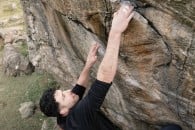
'I've gained so much from other peoples contributions, through Stone Circle I'd love to build a space where people can read and learn from past work, but also a place where they can put their own out'.
Having started collecting climbing materials almost as soon as he began climbing, Jim Pope has built up quite the collection of archival curiosities.
With the collection growing ever larger, earlier this year Jim began to share some of his favourite pieces on an Instagram page: Stone Circle.
Offering insights into the history of our sport that would otherwise be reserved for the lucky few who own physical copies of these pieces, Stone Circle provides sneak peeks into some of climbing's greatest stories - as they were originally told - as well as housing beautiful and iconic climbing photography from across the ages.
We got in touch with Jim to ask a few questions about how his collection began, which pieces he values most, and what he's still on the look out for:
What was the first piece you collected?
When I started climbing, I quickly became obsessed and wanted to consume all there was to know about the sport. In addition to reading the current magazines at the time, my climbing partners also encouraged me to read old magazines and stories from past generations.
The first climbing book I had would have been Jerry Moffat's biography and I branched out from there. Through reading 'Revelations' I heard of all these other British climbers, from the bigger names like Ben Moon and Ron Fawcett, to dark horses like Pete Kirton. I was fascinated by what they had done and would try to find out as much as possible through their biographies or in magazines/videos.
Once I had read a chunk of biographies of climbers and mountaineers I had a little collection going, one year at Christmas my uncle gave me his copy of 'Hard Rock', I found a copy of 'Classic Rock' online, and a few years after that my parents got me 'Extreme rock' for my birthday.
Like many people, I treasured these books so much and constantly find myself skimming their pages, either for some inspiration or to compare anecdotes after having climbed a route in them. Climbing literature can be so immersive, and reading about someone's experience, or seeing an iconic picture of a climb can create that spark that makes you think 'I want to climb that one day', and motivates you to go and do it. There are loads of climbs that aren't all that good, but by seeing a good photo of them or hearing a good story you end up getting on them and having a great time.
I love that you can make a climb as big as you want it to be. To one person it could just simply be a name and grade of a route they've never seen before, but if you want to get more out of it, there is so much depth, and so many layers that you can add to it from other people's stories or photos.
Books like 'The Games Climbers Play', 'Mirrors in the Cliffs' and 'The Climbing Essays' are great because they give you access to hundreds of pieces of the best climbing literature from over a long time span, but condensed into a single book. However, I'm quite obsessive, so after reading them in the books I would want to get the article to see it in print along with the photos, and that led to me collecting the Mountain magazines and Alpine journals, etc…
Which piece took you the longest to find?
I've been pretty lucky really, having always expressed an interest in these things people have been really kind and given old magazines or books when they have no longer wanted them, but a few things took a while. 'The Professionals' is a DVD that follows Francois Legrand and Yuji Hirayama around America as they try to do all of the country's hardest climbs in seven weeks. I had an eBay search saved for around a year and eventually someone put it up!
In the early 2000s Rob Elliot made a run of bouldering magazines called 'Friction'. I read a couple at some walls and thought they were great, but I've never seen any again or online, so that's taking the longest!
Which artefact is the one you value the most?
Probably my collection of 'Mountain' magazines, some of the writing in them is brilliant, and the photography is amazing. The covers are beautiful photos, and they get given lots of space, theres no large text obscuring the images.
A lot of the writing is longer format than what people get in magazines or on instagram today, which lets them explore deeper topics or ideas about climbing. With such high quality writing and images, it feels more like having an archive or reference point than a collection of magazines, and I use them a lot for inspiration for my own journalling or photography. Part of the reason I started Stone Circle was to open that up to more people.
What was your most fortuitous find?
Recently I was in Outside and checking out the second hand books section and found a journal from the Fell and Rock Climbing Club from 1928.
It's still in amazing condition, and the previous owner has attached newspaper articles from when the documented ascents made the national news.
Which piece do you look at most frequently?
'The Power Of Climbing' by David Jones is a book I flick through a lot. The black and white photography has some of my favourite climbing photos and the interviews are great.
David Jones concludes it well 'The text does represent the physical and mental power that climbing has over peoples lives, and the photographs illustrate the power contained within climbing at its highest level'.
Through the interviews in TPOC, you get a little insight into the climbers characters, motivations, philosophies, or stories from days out etc… I find certain people's approach or mindset inspiring, and often re-read sections to think and help shape my own views about climbing.
What's your favourite old article?
Theres so many its tough to choose, 'The Only Blasphemy' by John Long from Mountain 83, 1982 is one of my favourites, and 'Feeding the Rat' by Al Alvarez on the life of Mo Anthoine is my favourite book.

Throughout my time climbing I've gained so much from other peoples contributions, through Stone Circle I'd love to build a space where people can read and learn from past work, but also a place where they can put their own out.
I have a few photography zines coming out in the near future, and am working on some bigger book ideas. I'd love to build a community where others can share their projects too. It would be great to bring people together with talk nights or exhibitions in the future.
Check out Stone Circle here, and enjoy a selection of photos from Jim's collection below:
More Articles













































Comments
I don't understand... does copyright not exist anymore? How can Jim Pope claim copyright on all that material?
Hi Jon,
I don’t think it was ever Jim’s intention to claim copyright, we just did a batch import and wrongly left it as ‘Jim Pope Collection’. The article has now been updated.
No problem. There is of course the larger issue (non UKC related) that he is reproducing the material on Instagram, which I believe is still covered by copyright regulation. I appreciate the sentiment of wanting to share the 'archive' for all, in a non-commercial way, but then we could apply that to all guidebooks, couldn't we?
Just to follow up on this, I can confirm Jim didn't claim copyright on any of these images, he included the relevant details when he sent his scans through, it was my mistake when doing a batch upload that saw the copyright attributed to him, as Rob said. Apologies, those have now all been updated.
To make a moral point rather than a legal one: it seems ridiculous to me that copyright lasts so long. I think most people would agree with your point about guidebooks: the authors and contributors are typically still around, and still making money from them so clearly the work they've put in should be protected.
However with these mags etc. that Jim is sharing they're typically many years old at this point and the content of little commercial value. It feels to me a massive loss that this content is technically locked away until 70 years after the authors death. A handful of extremely valuable works get milked, while the other 99% of material rots into obscurity because no one is allowed to use it for anything.